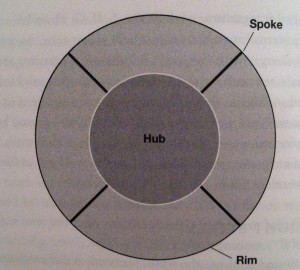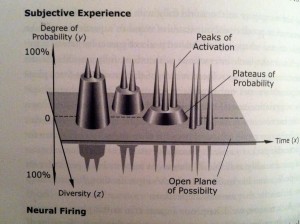Why Does Nearly Every Culture Engage In Some Form of Breath Practice? What is so special about the breath?
In part one, we saw how mindful meditation has a positive impact on mental health from the Buddhist perspective, as presented by Jack Kornfield during the two-day conference that both he and Dan Siegel gave about the “Neuroscience of Well-Being, Mindfulness and Love.”
In today’s post, you will have the opportunity to look at mindfulness and meditation from the vantage point of Dan Siegel’s work in neuroscience and attachment research.
Specifically, we will look at:
- The Breath’s 5 Special Features
- The Wheel of Awareness – a meditation practice created by Dan Siegel
- A Few Key Terms [and what they have to do with attunement and mental health]
- The Plane of Possibility
- A Singing Experiment
What’s So Special About the Breath?
According to Dan, it has the following key features:
- The breath is a unique experience that literally integrates inner and outer aspects of life [the air point of view of lungs]; inner and outer become interwoven; there is an implicit sense of knowing (sense of awareness with breath) with connectedness with world.
- The breath is one of the few functions of voluntary and involuntary (i.e., that happen automatically on their own and you can take it over and control it like blinking and swallowing].
In terms of regulation, it’s important to use awareness of the breath. One of the big challenges is that we cannot control everything in life. In many deep, deep ways, the breath is a good exercise of letting go [letting life happen]. I could control it but I let it happen.
- There is a huge difference between sensing and noticing your breath. You notice when you’ve become distracted. The exercise is filling awareness with the sensation of the breath. There are 2 circuits in the brain – noticing circuit and sensing circuit.
There is a huge debate about what mindfulness is – Is it sensing or noticing? Intention on focusing on breath – requires differentiation of noticing vs. sensing. [You use the noticing circuit to disengage the distraction and then use the sensing circuit to re-engage your focus.]
- When you breathe in, you’re activating the autonomic nervous system, sympathetic branch turns on inhalation; parasympathetic branch – this turns on exhalation, Inspiration – inhalation.
You’re balancing the sympathetic and parasympathetic brain, differentiating them and linking the two – example of integration. Awareness of the breath is an example of integration.
Autonomic nervous system becomes integrated with awareness of the breath and allows you to become more resilient.
- Lastly, Dan shared an hypothesis of his that has some support in which the breath has the opportunity in awareness to activate the nervous system – the circuit that is related to our capacity to attune to the intention of others.
This was related to the concept of mirror neurons and the SIMA process [sensory implications of motor action] – essentially meaning that the brain is an anticipation action machine that carries out present actions based on past experiences, mapping out intentions that it sees others doing. This plays a role in our empathic attunement with one another.
A Meditation Practice Created by Dan Siegel
Next, Dan walked us through his Extended Wheel of Awareness Practice. In this meditation, we were asked to imagine the below image of the “Wheel of Awareness” with the outer rim, the spokes and inner hub.
 |
| (p.94, The Mindful Therapist) |
While we were imagining parts of this wheel, Dan was asking us to notice and observe a series of things such as noises, smells, our breath etc. that reflect different levels of awareness. Here, Dan provides an 8 minute introduction to the practice.
In general, I find that Dan’s Wheel of Awareness meditations take more getting used to than Jack Kornfield’s. It was a bit hard for me to visualize this wheel and its various parts throughout the meditation.
That said, it was still a relaxing and pleasant experience for me but I think that I would need to do it several times before I truly felt comfortable with it. Also, had we been presented with a diagram like the above one, I know I would have an easier time with the visualization piece.
Other attendees shared a wide range of positive feelings of well-being including feeling more interconnected to others and the universe as a whole.
At this point in the conference, both Dan and Jack recommended that we try to engage in these types of mindfulness practices whenever there is difficulty or pain because they enable us to tolerate a range of experiences, as well as to tune into a center of well-being that is accessible to us all.
A Few Key Terms:
Below are definitions to the main concepts that Dan uses throughout his presentations:
• The mind = a “process that regulates the flow of energy and information”
• The human mind is not limited to the skin; it is both embodied and relational:
o It is a flow of energy and info that takes place within the body
o It is a flow of energy and info that also takes place between people
• Mindsight = the ability to see the internal world of self and others.
1. Insight into oneself, own childhood onto development
2. Empathy for others, putting self into mental shoes of others
3. Integration – differentiate elements of a system and then you link with compassionate communication
Mindsight is the key to secure attachment. It permits integrative communication in which individuals are honored for their differences and compassionate connections are cultivated that link one mind to another.
Interpersonal integration promotions the growth of integrative fibers in the brain.
A healthy mind creates integration within and between.
All regulation uses 2 dimensions:
1) monitors where you are going
2) modulates where you are going
We can teach people to monitor with more stability so they can see with more depth, focus and detail.
To strengthen the mind, we need to:
- Stabilize the lens through which you sense the inflow of information, through breath awareness.
- Modulate towards health
Dan had created the wheel of awareness practice with these two goals in mind.
In other words, when we practice this specific meditation practice, we are able to work on strengthening the mind from both the monitoring and modulating perspectives.
The Plane of Possibility
Being in the State of Health & Integration –> Open Plane of Possibility
The below image depicts Dan’s concept of the “plane of possibility.” He argues that energy is measured as potential on a spectrum of certainty to uncertainty.
There’s the open plane of possibility where everything/anything can happen [the probability of what’s happening is zero] and you are open and receptive. We can move in and out of this plane.
When you are getting ready to tackle a task [you are priming yourself], you rise up to the plateau of possibility. When you are definitely going to complete the task [or have completed it], you reach the peak of certainty.
 |
| (p. 202, The Mindful Therapist) |
When there’s fluid movement back and forth between peaks and plateaus, that is health. In other words, health enables the freedom by which people can move from peak of certainty to plateau of probability to open plane of possibility.
However, when people get stuck in a plateau, this is un-health. Examples of unhealth include scenarios when people may get stuck in depression, mania or obsessive thoughts. Alternatively, they may have recurring peaks in which they are constantly bombarded with worries or intrusive post-traumatic memories.
Another way of looking at the peaks and plateaus is that we may mistakenly see them as defining our identities [we may believe our propensity to behave in certain ways] when those views/behaviors are merely a reflection of a particular peak or plateau.
Meditation and integration enables us to increase both our and our clients’ capacities to move into the plane of open possibility.
With the wheel of practice mindfulness practice, the hub as a metaphor is a mechanism for the plane of possibility because life/uncertainty can be frightening. Mindfulness enables you to drop into this plane of possibility and to feel as wide as the sky and as deep as the ocean, as well as interconnected with others/the universe.
Without mindfulness and integration, you are likely to be lost in peaks and plateaus, as well as in the optical delusion of separateness.
A therapeutic relationship can be understood as bringing the client into a more fluid balance, integrated balance among peak, plateau and plane.
In many ways, mindfulness is the capacity to move to the open plane of possibility so you are truly receptive and open to what going on rather than laying on your judgments that filter what you see [or being swept away by thoughts, feelings memories etc.]
A Singing Experiment
Lastly, at one point, Dan had us [or several attendees] participate in the following three different singing variations to illustrate the concepts of integration and harmony vs. rigidity and chaos.
A. Everyone singing same sound [Ah]
B. Everyone singing a different song but covering their ears
C. The group gets to decide what song to sing and sings together
[A] It sounded boring with no change.
This was an example of linkage but no integration [rigidity].
[B] It was a mess; no one could hear what the other person was singing.
This was an example of differentiation but no linkage or integration [chaos].
[C] It sounded beautiful and warm.
This was an example of integration or linkage of differentiated parts [harmony]. This is what we strive for in ourselves – integration [for better mental/overall health].
What are your thoughts about the importance of the breath? What has your experience with the “Wheel of Awareness” practice been like? Please share any of your thoughts below 🙂
Like this post? If yes, please share it !
References:
Kornfield, J. & Siegel, D. (2013, November). The Neuroscience of well-being, mindfulness and love. Omega Institute, New York, NY.
Siegel, D. (2010). The Mindful therapist. W.W. Norton & Company, Inc. New York, NY.
Images: Omega NY and Music Notes



